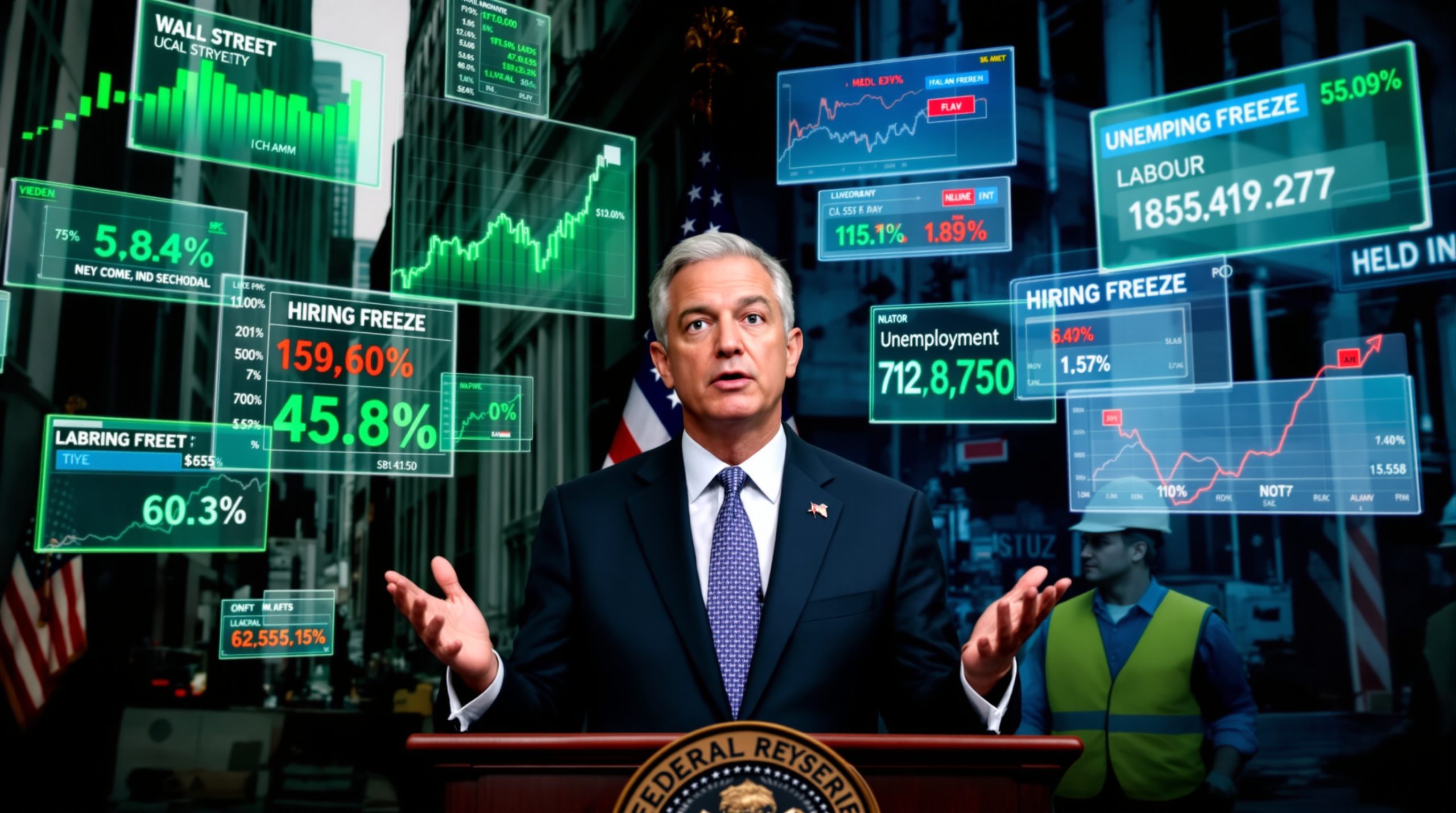What Is a Gold-Backed Treasury and Why Is It Being Discussed?
A gold-backed treasury represents an innovative financial instrument—a government bond that gives holders the option to redeem it at maturity for either its face value in dollars or a pre-specified weight of gold. This concept marks a partial return to gold standard principles that underpinned America's monetary system before 1971, when President Nixon severed the dollar's convertibility to gold during the "Nixon Shock."
The idea has gained renewed attention amid growing concerns about the Federal Reserve's monetary policies and their long-term implications for economic stability. With the Fed having paid over $200 billion in interest to banks in recent years—approximately 40% flowing to foreign institutions—questions about monetary accountability have intensified among policymakers, economists, and investors alike.
Understanding the Gold-Backed Treasury Concept
Unlike traditional treasury bonds that promise only dollar repayment, gold-backed treasuries create a direct link between government debt and physical gold reserves. This connection would reestablish a tangible anchor for the U.S. dollar for the first time in over five decades, offering a potential bridge between traditional fiat currency systems and asset-backed monetary frameworks.
"Gold has served as monetary bedrock for thousands of years," notes economist Judy Shelton in a 2025 interview. "Even legendary Fed chairs like Alan Greenspan and Paul Volcker acknowledged gold's historical importance in providing monetary stability."
The Current Monetary Context Driving Interest
The Federal Reserve's pivot to paying interest on reserve balances as its primary monetary policy tool has fundamentally altered America's monetary landscape. What began as an emergency measure during the 2008 financial crisis has evolved into what critics describe as a "perverse" structure where billions flow annually to commercial banks simply for maintaining deposits at the Fed.
This policy shift coincides with mounting concerns about inflation, federal debt sustainability, and US economic challenges. Since September 2022, the Federal Reserve has operated at a net loss, ending its long tradition of remitting profits to the Treasury and contributing to federal revenues.
How Would Gold-Backed Treasuries Work?
The proposed gold-backed treasury would function as a long-dated bond, potentially with a 50-year maturity, creating a bridge between America's 250th birthday in 2026 and its 300th in 2076. This long-term horizon serves both practical and symbolic purposes, allowing sufficient time for market adaptation while signaling a multigenerational commitment to monetary stability.
The Proposed Structure and Timeline
Proponents have suggested July 4, 2026—America's semiquincentennial—as an ideal launch date for these instruments. At maturity in 2076, bondholders would face a choice: accept payment in U.S. dollars or redeem for a predetermined amount of gold based on the bond's terms.
This redemption option would effectively reestablish a direct link between the dollar and gold for the first time since 1971, albeit in a limited and targeted fashion rather than a comprehensive return to the gold standard.
Collateral and Gold Reserves Considerations
The United States possesses the world's largest official gold reserves—approximately 261 million ounces valued at market prices exceeding $3,400 per ounce (worth nearly $900 billion). However, these reserves are carried on government books at just $11 billion, representing a significant discrepancy between market value and accounting treatment.
Implementing gold-backed treasuries would require "warehousing" a portion of these gold reserves as collateral against the issued bonds. This collateralization process would involve formal designation of specific gold holdings to back these obligations, creating a credible commitment mechanism for bond purchasers while utilizing an existing national asset that currently sits largely dormant on the government's balance sheet.
What Problems Could Gold-Backed Treasuries Address?
The proposal for gold-backed treasuries emerges in response to several interconnected challenges in America's current monetary system, particularly regarding Federal Reserve operations, interest payment mechanisms, and monetary policy accountability.
Federal Reserve Accountability Challenges
The Federal Reserve currently operates with significant independence in setting monetary policy. While independence from short-term political pressures has merits, critics argue this arrangement has evolved into a shield against proper oversight, particularly as the Fed has shifted from traditional open market operations to paying interest on reserve balances as its primary monetary policy tool.
This operational transformation has occurred with minimal congressional input despite its profound implications for government finances and the broader economy. Proponents of gold-backed treasuries suggest that reintroducing market-based disciplines could enhance accountability without compromising the Fed's ability to pursue its mandated objectives.
The Interest on Reserves Mechanism
In 2008, during the global financial crisis, the Federal Reserve gained emergency authorization to pay interest on reserve balances that commercial banks maintain at the Fed. Originally conceived as a temporary measure to prevent hyperinflation while implementing quantitative easing, this mechanism has become the Fed's primary monetary policy tool.
The Fed now pays approximately 4.4% interest on $3.4 trillion in commercial bank reserves, creating what critics characterize as a subsidy to the banking sector rather than a neutral monetary tool. This arrangement costs taxpayers approximately $150 billion annually, with a significant portion flowing to foreign-owned financial institutions—all without explicit congressional approval for these ongoing payments.
Financial Impact on Treasury and Taxpayers
Since September 2022, the Federal Reserve has operated at a loss, paying more in interest to banks than it earns on its own portfolio. This has ended the Fed's long tradition of remitting profits to the Treasury, which previously contributed billions to federal revenues. The situation is compounded by approximately $900 billion in unrealized capital losses in the Fed's portfolio, primarily from long-term bonds purchased at near-zero interest rates that have since declined in value as rates increased.
These losses, while "unrealized" in accounting terms, represent real economic costs that ultimately affect taxpayers through reduced Treasury remittances and potentially higher future taxation. Gold-backed treasuries could help address these issues by reintroducing market discipline and potentially reducing borrowing costs for the government.
Why Is Gold Being Reconsidered in Modern Monetary Policy?
Gold's resurgence in monetary discussions reflects growing concerns about inflation, currency stability, and the limitations of purely discretionary fiat money systems. This renewed interest spans from central bank boardrooms to state legislatures and retail investors.
Central Bank and State-Level Gold Trends
Recent trends show increasing interest in gold as a monetary anchor. Central banks globally have been purchasing gold at record rates—adding over 1,000 tonnes to their reserves in recent years—reflecting a strategic pivot toward hard assets and away from dollar-denominated reserves.
Simultaneously, states like Florida and Texas have passed legislation allowing gold to be used as a medium of exchange through electronic payment platforms. These state initiatives characterize gold as an inflation hedge and medium of exchange, with Governor Ron DeSantis of Florida stating that such measures aim to "restore economic and financial freedom to our citizens" and Governor Greg Abbott of Texas noting alignment with constitutional principles regarding money.
Historical Perspective on Gold's Monetary Role
Gold has served as a monetary anchor for thousands of years and was fundamental to America's founding economic system. The Constitution specifically mentions gold and silver in Article 1, Section 8, placing the power to regulate money with Congress in the same sentence as establishing official weights and measures—underscoring the founders' view of money as a standard measure of value rather than a policy tool.
This historical foundation provides context for current reconsiderations of gold's role. As former Fed Chair Alan Greenspan once noted, "Gold still represents the ultimate form of payment in the world. Fiat money, in extremis, is accepted by nobody. Gold is always accepted."
Market Signals and Public Sentiment
The price of gold has reached all-time high gold prices (above $3,400 per ounce as of 2025), suggesting market confidence in its role as a store of value amid monetary uncertainty. Public interest in gold as an investment and inflation hedge has also increased, with retailers like Costco reporting strong sales of gold products.
This sentiment reflects concerns about inflation and monetary stability that proponents of gold-backed treasuries aim to address. As traditional fiat currencies face unprecedented challenges from central bank digital currencies and private cryptocurrencies, gold's time-tested properties as money are receiving renewed attention from both institutional and retail market participants.
What Benefits Could Gold-Backed Treasuries Provide?
Proponents of gold-backed treasuries highlight several potential benefits spanning fiscal, monetary, and symbolic dimensions—each addressing different aspects of America's current economic challenges.
Potential for Lower Borrowing Costs
Advocates suggest that gold-backed treasuries could allow the U.S. government to borrow at lower interest rates because investors would pay a premium for the gold convertibility option. Similar to Treasury Inflation-Protected Securities (TIPS), which compensate bondholders for inflation through CPI adjustments, gold-backed treasuries would offer protection against currency devaluation, potentially attracting investors willing to accept lower yields in exchange for this protection.
This yield advantage could be particularly significant for long-dated bonds, where inflation uncertainty typically demands higher interest rates. By offering an alternative protection mechanism tied to gold rather than government-calculated inflation statistics, these instruments could appeal to investors seeking diversification from traditional inflation hedges.
Restoring Market Discipline to Monetary Policy
A gold-backed treasury program could establish what economists call a "price rule" for Federal Reserve officials, providing a market-based signal about monetary policy effectiveness. If gold prices rise significantly relative to the dollar, it would indicate potential monetary excess, while stable gold prices would suggest appropriate monetary balance.
This market-based feedback mechanism would complement or potentially replace the Fed's current discretionary approach to interest rate setting, introducing greater discipline into the monetary system without requiring a full return to the rigid constraints of the historical gold standard.
Symbolic Commitment to Sound Money Principles
Beyond practical financial benefits, gold-backed treasuries would represent a symbolic commitment to sound money principles that have underpinned America's most prosperous economic periods. By establishing what proponents call a "beachhead" for sound money, the program would signal the government's dedication to both sound finances (balanced budgets) and sound money (stable purchasing power).
This symbolic dimension shouldn't be underestimated in its potential to shape expectations and restore confidence in America's long-term economic governance. By tying current policy decisions to a multi-generational timeline (2026-2076), the program would encourage policymakers to consider monetary decisions beyond electoral cycles and immediate political considerations.
What Challenges and Criticisms Face This Proposal?
Despite its potential benefits, the gold-backed treasury proposal faces significant challenges and criticisms that must be addressed for successful implementation.
Historical Lessons from Previous Gold Standards
Critics point to the experience that led to the end of gold convertibility in 1971, when foreign governments (particularly France) began redeeming dollars for gold, draining U.S. reserves. Any new gold-backed instrument would need safeguards against similar scenarios, especially given current geopolitical tensions and efforts by countries like China and Russia to diversify away from dollar-denominated assets.
The proposal must contend with the historical reality that fixed exchange systems eventually face speculative attacks when economic fundamentals diverge from the fixed rate. Designing a system that maintains credibility while providing flexibility remains a significant challenge.
Federal Reserve Independence Concerns
The proposal faces resistance from those who view central bank independence as essential for economic stability. Former Fed officials, including Janet Yellen (now Treasury Secretary), have emphasized the importance of maintaining the Fed's operational independence from political pressure, arguing that monetary policy decisions should be based on economic conditions rather than political considerations.
Implementing gold-backed treasuries would represent a significant shift in the relationship between Treasury and Fed operations, potentially constraining the Fed's discretion in pursuing its dual mandate of price stability and maximum employment.
Implementation and Transition Complexities
Moving from the current system to one that incorporates gold-backed treasuries would involve complex transition issues, including determining appropriate gold-to-dollar ratios, managing market expectations, and addressing potential international monetary implications. These practical challenges would require careful planning and execution to avoid market disruptions.
Questions remain about the specific mechanics: How would the gold-to-dollar ratio be determined? Would it float with market prices or be fixed at issuance? How would the Treasury manage its gold reserves to ensure redemption capacity? These technical details would significantly impact the program's credibility and effectiveness.
How Does This Fit Into Broader Monetary Reform Discussions?
The gold-backed treasury proposal exists within a broader context of calls for monetary reform, ranging from incremental adjustments to fundamental "regime change" in how America manages its currency and financial system.
Calls for Federal Reserve Structural Reform
Treasury Secretary Scott Bessent has called for a "sweeping review" of Fed policies and operations, comparing the situation to how the FAA would face a full investigation after multiple mistakes. Senators have proposed legislation to audit the Fed, while some financial leaders have suggested the Fed Chair should resign to preserve institutional legitimacy.
These reform discussions reflect growing concerns about the Fed's expanding role in the economy, its balance sheet management, and the unintended consequences of its policies. Gold-backed treasuries represent one potential element in this broader reform landscape.
Competing Monetary Reform Approaches
Various approaches to monetary reform are being discussed, ranging from more modest adjustments to the Fed's current framework to more fundamental changes in monetary policy rules. These include reconsidering the Fed's interest on reserves policy, implementing rules-based monetary policy frameworks (such as the Taylor Rule), and enhancing congressional oversight of Fed operations.
Some reformers advocate for a return to the classical gold standard, while others suggest novel approaches like gold reintegration into the monetary system or productivity-linked monetary targets. Gold-backed treasuries offer a middle path—maintaining the existing fiat currency system while introducing a gold-linked component that could evolve based on market acceptance and economic outcomes.
Political and Administrative Feasibility
The proposal has reportedly received positive responses from some within the current administration, suggesting potential political feasibility. However, implementation would require navigating complex institutional relationships between the Treasury, Federal Reserve, and Congress, as well as addressing potential legal and regulatory hurdles.
The concept's appeal spans traditional political divisions, with aspects appealing to fiscal conservatives (market discipline, sound money) and progressives (reducing bank subsidies, enhancing accountability). This cross-ideological appeal could create unusual political coalitions in support of the concept.
What Are the Investment and Economic Implications?
Introducing gold-backed treasuries would create ripple effects throughout financial markets and the broader economy, affecting everything from portfolio management strategies to inflation expectations.
Potential Impact on Treasury Markets
Introducing gold-backed treasuries would create a new asset class within government securities markets. This could affect pricing and demand dynamics across the yield curve, potentially influencing conventional Treasury yields and creating new hedging and investment opportunities for market participants.
Institutional investors might recalibrate fixed-income allocations to incorporate these new instruments, particularly for liability-matching strategies where long-term inflation protection is valuable. Sovereign wealth funds and central banks seeking to diversify dollar reserves might find these instruments particularly attractive as they combine dollar exposure with gold protection.
Effects on Gold Markets and Pricing
A significant gold-backed treasury program would likely impact global gold markets, potentially increasing demand and price stability for the metal. The program would effectively create additional monetary demand for gold, complementing its existing roles in jewelry, industry, and investment.
Gold mining companies and producers could see increased valuation as the metal's monetary role expands, while gold investment products (ETFs, physical bullion) might face competition from these new government-backed instruments that offer both gold exposure and interest income.
Broader Economic and Financial System Effects
By reintroducing a partial gold link to the monetary system, the proposal could influence inflation expectations, currency markets, and global financial flows. Proponents suggest it would enhance monetary stability and reduce financial speculation, while critics might worry about constraints on monetary policy flexibility during economic crises.
The program could also influence international monetary relationships, potentially accelerating discussions about the dollar's global reserve currency status and encouraging other nations to consider similar gold-linked instruments for their government debt.
FAQs About Gold-Backed Treasuries
Would this return the U.S. to a full gold standard?
No, the proposal represents a partial and gradual reintroduction of gold into the monetary system through specific long-term treasury instruments, not a comprehensive return to the pre-1971 gold standard. The existing fiat currency system would continue to operate alongside these new instruments.
The approach has been described as establishing a "beachhead" for sound money principles rather than an immediate regime change. The gold-linked bonds would create a market-based signal about monetary policy effectiveness without constraining day-to-day Fed operations in managing the broader money supply.
How would gold-backed treasuries affect everyday Americans?
While most Americans wouldn't directly purchase these long-term bonds, proponents suggest the system would benefit everyone by promoting monetary discipline, potentially reducing inflation, and establishing greater financial stability. This could translate to more stable purchasing power and economic planning horizons.
The mechanism could also reduce the current "subsidy" flowing from taxpayers to banks through the Federal Reserve's interest on reserves payments, potentially improving fiscal outcomes without requiring tax increases or spending cuts.
Could the government default on the gold redemption promise?
As with any government commitment, there is always some political risk. However, the U.S. gold reserves significantly exceed what would likely be needed for initial gold-backed treasury issuances, and the long-term nature of the bonds (potentially 50 years) would provide substantial time for adjustment if necessary.
The program could include explicit provisions for managing this risk, such as limiting the total volume of issuance relative to gold reserves or establishing a transparent process for addressing potential redemption challenges decades in advance of maturity.
How would this affect the Federal Reserve's operations?
The proposal would not directly change the Fed's day-to-day operations but would establish a market-based signal about monetary policy effectiveness. Over time
Ready to Capitalise on the Next Major Mineral Discovery?
Stay ahead of the market with Discovery Alert's proprietary Discovery IQ model, which provides instant notifications when significant ASX mineral discoveries are announced. Explore our dedicated discoveries page to understand how historic mineral discoveries have generated substantial returns, and begin your 30-day free trial today.




